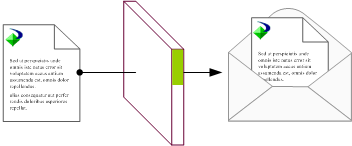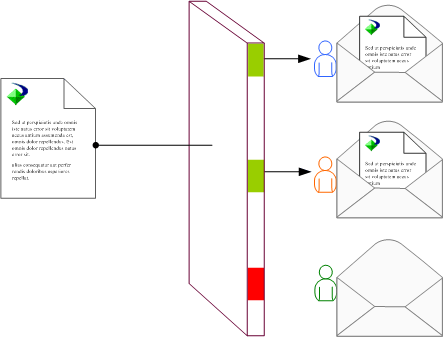SAP BusinessObjects Enterprise InfoView User's Guide
Delivery rules
Note: This feature is unavailable for
Web Intelligence documents.
“Delivery rules” affect how documents
in publications are processed and distributed. When you set delivery rules on
documents, you indicate that the publication will be delivered to recipients
only if the content in the documents meets certain conditions. There are two
types of delivery rules:
- Recipient delivery ruleIf the data in the recipient's instance meets the delivery rule, the instance is delivered to the recipient.
- Global delivery ruleIf the data in a designated document meets the delivery rule, the publication is delivered to all recipients.Note: The designated document for a global delivery rule can be different from the document or documents used in a publication. For example, you can set a global delivery rule on a Desktop Intelligence document used as a dynamic recipient source instead of a Desktop Intelligence document in the publication.
If a publication has recipient and global delivery
rules, the global delivery rule is evaluated first to determine whether the
publication will be processed. If the publication meets the global delivery
rule, the system then evaluates the recipient delivery rules to determine which
instances to process and distribute for each recipient.
How you set delivery rules depends on the document
type that you want to publish. For Crystal reports, you specify a delivery rule
based on a named alert that the report designer creates in the Crystal report.
For
Desktop Intelligence
documents, you specify a formula expression. You can also set a delivery rule
based on whether the personalized publication contains any data.
The diagram
“Global delivery rule met” illustrates how an
alert-based global delivery rule works. Here the global delivery rule is set on
a document in the publication. The Crystal report has a Revenue alert for
values greater than 100,000. The publisher creates a global delivery rule based
on the Revenue alert so that the Crystal report is only delivered to all
recipients if revenue exceeds 100,000. In this case the delivery rule is met,
so the Crystal report is delivered.
The diagram
“Recipient delivery rule unmet” illustrates how
a recipient delivery rule works. The publisher sets a recipient delivery rule
for the Crystal report so that the report is delivered to recipients only if
the report contains data for that recipient. When the report is personalized
for each recipient, Green Recipient does not have data in the Crystal report.
This means that only Blue Recipient and Orange Recipient receive the
publication.
For publications that contain multiple documents
and objects, each document can have its own recipient delivery rule. When you
do this, you have the following options for processing and delivery:
- If a document in the publication fails to meet its recipient delivery rule for a recipient, the entire publication will not be delivered for that recipient.
- If a document in the publication fails to meet its recipient delivery rule for a recipient, that document will not be delivered, but all other documents in the publication will be delivered for that recipient.
Delivery rules are useful because they allow
publications intended for a large number of recipients to be processed and
distributed more efficiently. Consider a situation in which a publisher at an
insurance company creates a publication for its clients that contains the
following objects:
- An insurance bill (personalized Crystal report).
- A monthly statement (personalized Crystal report).
- A payment methods brochure (PDF).
In the insurance bill, there is an Amount Due alert
for values greater than zero. The publisher creates an Amount Due recipient
delivery rule for the insurance bill so that the insurance bill is published
and distributed only if a client owes the insurance company a payment. The
publisher also specifies that the entire publication will not publish if the
insurance bill fails to meet the delivery rule because he does not want clients
to receive a monthly statement and a brochure when they do not have to pay a
bill. When the publication is run, the publication is processed and distributed
to clients who owe payments only.
Note: If a Crystal reports publication is scheduled
to print when the publication runs, the print job occurs regardless of whether
a document in a publication fails to meet a delivery rule and is not delivered
to a recipient. This is because print jobs are processed during
personalization, and delivery rules are applied to publications after
personalization.
|
SAP BusinessObjects http://www.sap.com/sapbusinessobjects/ Support services http://service.sap.com/bosap-support/ Product Documentation on the Web http://help.sap.com/ |

